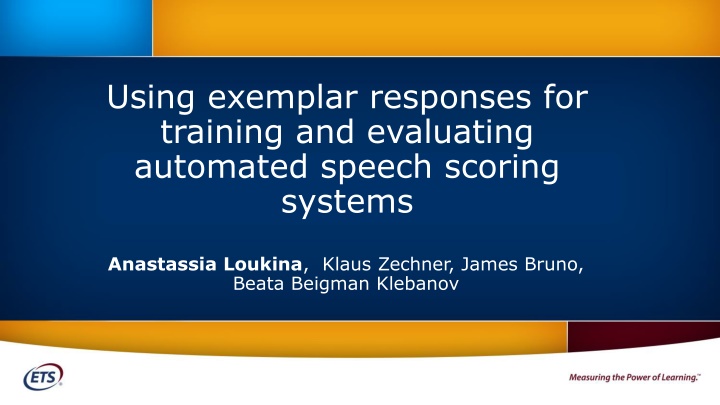
Enhancing Automated Speech Scoring with Exemplar Responses
Exploring the use of exemplar responses for training and evaluating automated speech scoring systems in English language proficiency tests. Understand the challenges in obtaining reliable human scores and how training on clean data can improve system performance. Leveraging data from an exemplar corpus to build models with key features for scoring responses effectively.
Uploaded on | 1 Views
Download Presentation

Please find below an Image/Link to download the presentation.
The content on the website is provided AS IS for your information and personal use only. It may not be sold, licensed, or shared on other websites without obtaining consent from the author. If you encounter any issues during the download, it is possible that the publisher has removed the file from their server.
You are allowed to download the files provided on this website for personal or commercial use, subject to the condition that they are used lawfully. All files are the property of their respective owners.
The content on the website is provided AS IS for your information and personal use only. It may not be sold, licensed, or shared on other websites without obtaining consent from the author.
E N D
Presentation Transcript
Using exemplar responses for training and evaluating automated speech scoring systems Anastassia Loukina, Klaus Zechner, James Bruno, Beata Beigman Klebanov
Context English language proficiency tests often include speaking section Different types of tasks: read aloud, sentence repeat, picture description, dialogue tasks This talk: Tasks that elicit spontaneous speech for about 1 minute The response is recorded and sent for scoring
Automated speech scoring ASR Scoring model ML algorithm trained on human scores Feature computation Number of pauses, similarity to native model, vocabulary complexity, grammatical complexity etc. Score or NaN Other signal processing Filtering model Set of rules and classifiers to identify non- scoreable responses Pitch Amplitude Formants
Problem Obtaining reliable human scores for constructed responses is hard: Response factors: multidimensional production mapped to a single scale Rater factors Ensuring reliability for spoken responses even harder Relatively low human-human agreement at the level of individual response (r=0.55-0.65).
Solution Human scoring: Test-takers answer several questions Responses from the same test taker are scored by a different raters The final aggregated score is highly reliable (r>0.9) Automated scoring: Engines are trained using human scores at response level Previous studies suggest that removing low-agreement ( hard ) cases from the training set may improve system performance (Beigman Klebanov & Beigman 2014, Jamison & Gurevych 2015). Can we improve system performance by training on clean data?
Data Exemplar corpus Main corpus Randomly sampled from responses to a large-scale language proficiency assessment 6 different types of questions eliciting spontaneous speech (1,140 different questions) 683,694 responses scored on a scale 1-4. 8.5% double scored: r=0.59 Exemplar responses from the same assessment selected for rater training/monitoring Same 6 types of questions (800 different questions) 16,257 responses sampled to obtain the same score distribution as in the main corpus Only includes responses where multiple experts agree on the same score
Model building 70 features extracted for each response: Delivery: fluency, pronunciation, prosody Language Use: vocabulary, grammar Main train Exemplar train 7 different machine learning algorithms: OLS, Elastic Net, Random Forest, Multilayer perceptron regressor Separate models trained for 6 types of questions Main test Exemplar test
Model performance: within corpus Model trained and evaluated on exemplar responses consistently outperform those trained and evaluated on the main corpus r=0.66 r = 0.79 There is no major difference between different learners
Model performance: across corpora Training on exemplar responses does not lead to improvement in performance on the main corpus Main: r = .66 Exemplar: r = .64 Exemplar: r = .79 Main: r = .8 Training on main corpus does not lead to degradation in performance on exemplar responses
Difference in N in training set Exemplar corpus Main corpus Randomly sampled from responses to a large-scale language proficiency assessment 683,694 responses Only includes responses where multiple experts agree on the same score 16,257 responses sampled to obtain the same score distribution as in the main corpus. Main* corpus Randomly sampled from the training partition of the Main corpus Same N as in the training partition of the exemplar corpus: 12,398 responses
Main* vs. Exemplar There is no difference when models are evaluated on the main corpus Main: r = .66 Exemplar: r = .64 Main*: r = .64 Main: r = .8 Exemplar: r = .79 Main*: r = .77 Training on exemplar responses leads to a better performance on exemplar responses Large training set gives the best performance
Modelling the differences (N=4,686,507) Error2 ~ learner + train_set * test_set + (1|response) + (1| model) Coefficient 0.291*** -0.105** -0.014*** -0.002* -0.001*** -0.001*** 0.002*** 0.003*** 0.007*** 0.008*** 0.016** 0.018** Intercept test_set.Exemplar train_set.main train_set.main* Learner.HuberRegressor Learner.MLPRegressor Learner.ElasticNet learner.GradientBoostingRegressor Learner.LinearSVR Learner.RandomForestRegressor train_set.main:test_setExemplar train_set.main*:test_set.Exemplar
What if we had more exemplar responses? Training on Exemplar responses has a small advantage for a very small N but not when the training set is sufficiently large. Training on Exemplar responses has a clear advantage for small N. This decreases with the increase in the size of the training set.
Do the models generate different predictions? Different learners trained on the same data sets: r = .97 (min r = .92). Same learner trained on different datasets: r = .98 (min r = .95). Different learners trained on different corpora seem to be producing essentially the same predictions
Conclusions As long as you have enough training data it doesn't matter whether you train on exemplar responses or random sample, at least if the response-level noise is random. The choice of training set (exemplar vs. random) has a major effect on the estimates of model performance Unless the number of available responses is really small (~1K), the cost of creating an Exemplar corpus is likely to outweigh benefits. Cleaning up the evaluation set or collecting a larger set of training responses is likely to be more useful.
Further error analysis (Main corpus) Sources of errors for 80 responses with the highest scoring error: 30% Noise in human labels. 22.5% Errors in pipeline: inaccurate ASR 30% Responses differentiated along dimensions not measured by features

